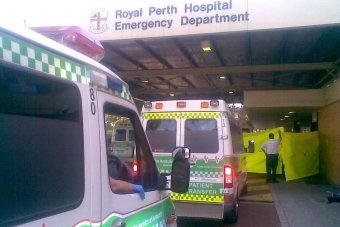WA Health Minister Kim Hames says he has run out of patience on the issue of ambulance ramping and has ordered hospitals to take responsibility for patients waiting for admission.
Dr Hames told a budget estimates committee hearing he had “lost his temper” after analysing data which showed no clear correlation between high ramping periods and the number of patients or bed availability.
“You find days of high ramping with less presentations than a day, a year ago. So ramping is worse with less patients and more availability of beds,” he said.
“So I’ve given up. I’ve lost my temper on this.”
He said he had instructed the city’s three tertiary hospitals that they, not ambulance drivers, would be responsible for the care of patients 30 minute after they arrived at the emergency department.
“Once the patient arrives at the hospital, it is legally the responsibility of the hospital,” Dr Hames said.
“It is not the responsibility of the ambulance drivers.
“So I have passed on instructions that will become as strong as they need to be, that hospitals are no longer allowed to have ramping.”
The anti-ramping measures will be implemented at Perth’s three tertiary hospitals: Fiona Stanley Hospital, Sir Charles Gairdner Hospital and Royal Perth Hospital.
Hospitals to take charge within 30 minutes of patient’s arrival
Under the new procedures hospital staff must start to prepare to take over care 10 minutes after the patient arrives.
After 20 minutes, the paramedics will start a handover.
The handover will be completed by 30 minutes, when the hospital assumes responsibility for the patients.
Opposition Health spokesman Roger Cook questioned whether emergency departments would have sufficient staff to deal with the change.
Mr Cook said the measure appeared to be either under-resourced or unfunded.
“Your staffing is being held at current levels, but you’re now actually shooting from the hip perhaps, saying that you’re doing to employ extra staff in ED looking after patients,” he said.
“Therefore what you’re actually suggesting is cutting other areas – or this is a totally unfunded program.”
Dr Hames said he could not predict how many staff would be required because it would depend on the number and condition of patients.
“My guesstimate is that it will be a minimum of two, and more staff will be sent out or moved to that area if there are a significant number of patients,” he said.
He said it would be the responsibility of the hospitals to fill those roles.
“Hospitals altogether have significant numbers of staff and how they distribute those staff will be a matter for the hospitals,” he said.
Dr Hames said the Health Department’s acting director-general, Bryant Stokes, was in the final stages of discussions with the hospitals about implementing the new policy.
The anti-ramping measures will take effect from July 1, 2015.

